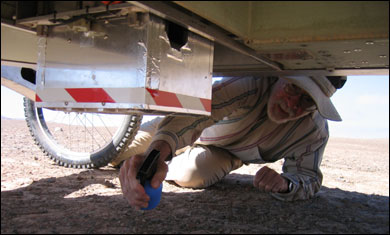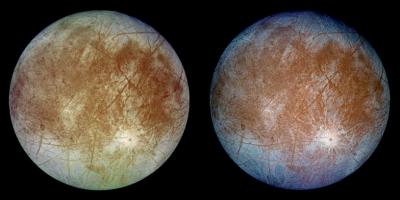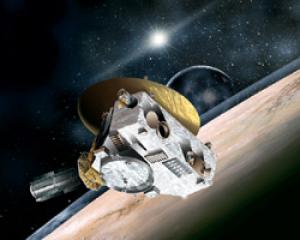by Paul Gilster | Mar 17, 2005 | Exoplanetary Science
PlanetQuest is a distributed computing project aimed at using spare computer cycles to search for extrasolar planets. The search will use the transit method, in which a planet is detected when it crosses the face of its primary as seen from Earth. That requires subjecting the data from thousand of stellar images to analysis, a job that would tax the largest supercomputer, but perhaps not the kind of distributed network that SETI@Home has already put to work in its search for extraterrestrial intelligence.
Nobody knows for sure how many stars have planets that line up edge-on to our own line of sight, but estimates run between 0.5 and 10 percent. Instead of studying a single star for long periods, as is done in the radial velocity method that has found most extrasolar planets so far, the transit approach has to rely on images of highly crowded star regions, where tens of thousands of stars can be viewed at once. The best area, then, is in the plane of the Milky Way. Stars captured in the project’s images will be be analyzed to determine their light curve, with PlanetQuest’s transit detection algorithms testing for the presence of a planet.
A beta version of the software should be available at the PlanetQuest site by the end of 2005, with the project going live in 2006. PlanetQuest notes that while finding terrestrial planets around Sun-like stars is beyond current capabilities, it may well be possible to find such planets around M-class red dwarfs. Another bonus: PlanetQuest may be able to detect optical SETI signals, a significant addition to existing efforts in that area.
A list of research articles by members of the PlanetQuest team can be found here. And Wired Magazine wrote the project up in a recent article by Amit Asaravala.
by Paul Gilster | Mar 16, 2005 | Astrobiology and SETI, Autonomy and Robotics
As our space probes go deeper into the Solar System and beyond, they’ll be required to become fully autonomous, making decisions about courses of action in space or on distant planetary surfaces. Each time we test a technology in a nearby environment, we’re building toward such autonomy. Consider the announcement that Carnegie Mellon scientists have discovered life with an automated rover — life here on Earth, that is.
The scene is Chile’s Atacama Desert, a harsh, dry region that acts as a surrogate for the even more hostile Martian terrain. “Life in the Atacama” is a three-year program designed to develop techniques for life detection via remote sensing. The group chose the region because it is one of the most arid on Earth, where rain is so rare that it is measured in millimeters per decade, and the high elevation makes solar radiation intense. Here, a rover named Zoë is deploying new technologies in the hunt for life.
Carnegie Mellon’s Alan Waggoner has been presenting results of Zoë’s life detection experiments to the 36th Lunar and Planetary Science Conference (March 14-18) in Houston. The rover has been able to detect lichen and bacterial colonies in the most arid parts of the desert. According to Waggoner, who is director of the Molecular Biosensor and Imaging Center at the university’s Mellon College of Science:
“We saw very clear signals from chlorophyll, DNA and protein. And we were able to visually identify biological materials from a standard image captured by the rover.
“Taken together, these four pieces of evidence are strong indicators of life. Now, our findings are being confirmed in the lab. Samples collected in the Atacama were examined, and scientists found that they contained life. The lichens and bacteria in the samples are growing and awaiting analysis.”

Image: Alan Waggoner, Atacama team member and director of the Molecular Biosensor and Imaging Center at Carnegie Mellon, crouches next to Zoë, a robotic rover, to spray the life-detection probes onto the sample area. In the future, the probes will be sprayed from instrumentation located underneath the rover. Credit: Carnegie Mellon University.
Waggoner’s team uses a fluorescence imager installed beneath the rover to detect signals from chlorophyll-based life, and deploys special dyes that light up only when they bind to nucleic acids, protein, lipids or carbohydrates. The system can function in full daylight using the shade of the rover for protection, a useful feature since Zoë needs solar power to operate. A remote science team in Pittsburgh gave the rover operating instructions while a ground team collected rover samples for examination in their own laboratories. The results: not a single false positive. Every sample the rover reported as positive for bacteria was found to contain bacteria.
Centauri Dreams‘ take: Plans call for Zoë to operate eventually with full autonomy, traveling with a complete instrumentation package up to 50 kilometers in a two-month period. This is technology with great implications for the hunt for life on Mars, and it points the way to the kind of automated systems we’ll use not only on Titan but much farther afield as we move into the Kuiper Belt. You can read more in this article in Carnegie Mellon Today. Field reports, including images and movies from the Atacama project, can be found here.
by Paul Gilster | Mar 15, 2005 | Missions, Outer Solar System |
With the Jupiter Icy Moons Orbiter (JIMO) on hold, NASA is talking to the European Space Agency about a possible joint mission to Europa. A BBC story reports that a prime driver for ESA is the need to use radioisotope thermal generators (RTGs) on the mission, a power source with which the Europeans have little experience. RTGs are needed on missions to the outer planets because they increase the power available to the spacecraft, allowing for a wider range of experiments with more sophisticated instruments. Solar panels remain an option in Jupiter space, but aren’t nearly as effective.
The other driver, of course, is the recent success of the Cassini/Huygens combined mission, whose stunning images of the Saturnian system and data from the Titan descent and landing have many scientists now thinking of Europa. The moon’s cracked ice seems to have been shaped by tidal forces from Jupiter, with reason to believe that an ocean of liquid water might be found beneath an ice crust tens of kilometers deep. Are microorganisms — or other forms of life — feasible in such an environment? A dual orbiter/lander mission, or perhaps a Jupiter orbiter acting as relay for a Europa orbiter, would provide many answers, and could be flown at much lower cost than JIMO.

Image: Two views of the trailing hemisphere of Jupiter’s ice-covered satellite, Europa. The left image shows the approximate natural color appearance of Europa. The image on the right is a false-color composite version combining violet, green and infrared images to enhance color differences in the predominantly water-ice crust of Europa. Dark brown areas represent rocky material derived from the interior, implanted by impact, or from a combination of interior and exterior sources. Credit: Jet Propulsion Laboratory.
Meanwhile, a team at the German Aerospace Centre is working on a prototype melting probe called SUSI, which could eventually be powered by a radioactive heating unit and used on a Europa lander (the prototype is a hollow aluminum cylinder with heat supplied by an attached electrical cable). Such a probe could analyze ocean water for microbial life, either returning to the surface with samples or beaming data through the ice to the lander on the surface and thence to an orbiter or relay satellite. Plans are to test the prototype in Greenland or the Antarctic.
The NASA/ESA discussions are only in their preliminary stages, and any Europa mission resulting from them would launch no earlier than 2016. But ESA sounds serious about the idea. The BBC quotes the agency’s David Southwood: “I’d much rather do this with RTGs, and that makes it almost certainly a joint venture with the Americans and why should we do it separately? This was waiting to happen. Someone just had to say it.”
by Paul Gilster | Mar 14, 2005 | Missions, Outer Solar System
January 11 to February 14, 2006 marks the launch window for NASA’s New Horizons mission to Pluto and the Kuiper Belt. At the moment, New Horizons is in pieces, or as principal investigator Alan Stern puts it in an update on the mission, it’s in “…boards, boxes and a spacecraft bus on the cleanroom floor at the Johns Hopkins Applied Physics Laboratory…” The high-gain antenna is being checked, and the main computer system installed. According to Stern:
The bird also received a guidance, navigation and control software load, and the first testing of the autonomy system (that provides for fault protection) has taken place. Coming soon to the spacecraft are the redundant flight computer, the gyros and the Ralph remote-sensing package.
We are now approaching the time – only weeks away – when the last avionics box goes on the spacecraft and New Horizons is dressed in thermal blankets for environmental testing in a large vacuum chamber at NASA Goddard Space Flight Center.
New Horizons would complete our survey of the planets by conducting a flyby study of Pluto and its moon Charon in 2015 before pushing on into the Kuiper Belt. There are those who consider Pluto simply the largest Kuiper Belt object and not a planet at all, but in any case, the exploration of the small, icy worlds beyond Pluto’s orbit is becoming a priority for our understanding of how the Solar System formed. As for Pluto, even the best Hubble view cannot bring us more than a hint of surface features on its enigmatic surface.
 Image: Artist’s concept of the New Horizons spacecraft during its planned encounter with Pluto and its moon, Charon. The craft’s miniature cameras, radio science experiment, ultraviolet and infrared spectrometers and space plasma experiments would characterize the global geology and geomorphology of Pluto and Charon, map their surface compositions and temperatures, and examine Pluto’s atmosphere in detail. The spacecraft’s most prominent design feature is a nearly 8-foot (2.1-meter) dish antenna, through which it would communicate with Earth from as far as 4.7 billion miles (7.5 billion kilometers) away.
Image: Artist’s concept of the New Horizons spacecraft during its planned encounter with Pluto and its moon, Charon. The craft’s miniature cameras, radio science experiment, ultraviolet and infrared spectrometers and space plasma experiments would characterize the global geology and geomorphology of Pluto and Charon, map their surface compositions and temperatures, and examine Pluto’s atmosphere in detail. The spacecraft’s most prominent design feature is a nearly 8-foot (2.1-meter) dish antenna, through which it would communicate with Earth from as far as 4.7 billion miles (7.5 billion kilometers) away.
Credit: Johns Hopkins University Applied Physics Laboratory/Southwest Research Institute (JHUAPL/SwRI)
After launch by an Atlas V modified with a Boeing-built extra stage, New Horizons will slingshot past Jupiter, a gravity assist that will knock five years off the time needed to reach Pluto. Power will come from a radioisotope thermoelectric generator (RTG) that creates electricity from the decay of its radioactive fuel. And it’s the RTG — and public reaction to it — that we’re waiting on. A Draft Environmental Impact Statement for the New Horizons mission has been released for a 45-day public comment period that ends April 11. NASA will host meetings at the Florida Solar Energy Center in Cocoa, followed by reviews that will decide (in the fall) whether or not New Horizons flies.
by Paul Gilster | Mar 12, 2005 | Deep Sky Astronomy & Telescopes
We always thought that the real impetus to the theory of ‘dark energy’ came from the discovery that the expansion of the universe seems to be accelerating. But an article in New Scientist points out that Allan Sandage (Carnegie Observatories, Pasadena) had studied evidence that might have led to the theory of dark energy way back in 1972.
Sandage was working with ‘peculiar velocities,’ deviations in the normal rate of cosmic expansion caused by the gravitational pull between groups and clusters of galaxies. And he had seen that galaxies just outside the Local Group showed velocities that were below what was expected. Fabio Governato of the University of Washington has now plugged dark energy into a computer model of galaxy formation and finds that this force matches nicely with the peculiar velocities for galaxies in regions like the Local Group. The Sandage data plus the new computer model, it can be argued, point to dark energy.
You can find an abstract of Governato’s study, “The signature of dark energy on the local Hubble flow,” here. From the preprint:
The environment of our Local Group provides new, independent evidence for the existence of dark energy on scales of just a few Mpcs [a megaparsec equals one million parsecs], corroborating the evidence gathered from observations of distant objects and the early Universe.
But as the New Scientist article indicates, some astronomers argue that factors other than dark energy can explain the galactic slowdown. Clearly we’re a long way from understanding dark energy, or even knowing if we are observing its effects in this case, but it’s always intriguing to find the seeds of potential discovery in observations that are decades old, like Sandage’s. It makes us wonder what data might currently be staring us in the face that could change the way we view other aspects of the cosmos.


 Image: Artist’s concept of the New Horizons spacecraft during its planned encounter with Pluto and its moon, Charon. The craft’s miniature cameras, radio science experiment, ultraviolet and infrared spectrometers and space plasma experiments would characterize the global geology and geomorphology of Pluto and Charon, map their surface compositions and temperatures, and examine Pluto’s atmosphere in detail. The spacecraft’s most prominent design feature is a nearly 8-foot (2.1-meter) dish antenna, through which it would communicate with Earth from as far as 4.7 billion miles (7.5 billion kilometers) away.
Image: Artist’s concept of the New Horizons spacecraft during its planned encounter with Pluto and its moon, Charon. The craft’s miniature cameras, radio science experiment, ultraviolet and infrared spectrometers and space plasma experiments would characterize the global geology and geomorphology of Pluto and Charon, map their surface compositions and temperatures, and examine Pluto’s atmosphere in detail. The spacecraft’s most prominent design feature is a nearly 8-foot (2.1-meter) dish antenna, through which it would communicate with Earth from as far as 4.7 billion miles (7.5 billion kilometers) away.
